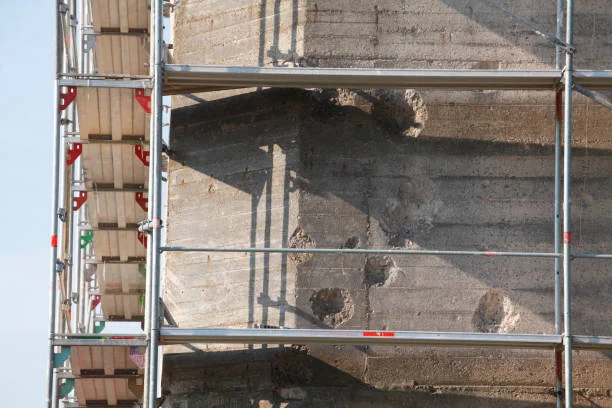Concrete may be one of the most durable building materials, but even it shows signs of age. When repairs are needed, the challenge isn’t just structural—it’s aesthetic. Poorly matched patches can stand out like scars, compromising the appearance and even the perceived value of a structure. Today, we explore the subtle art of making concrete repairs that don’t just fix the problem but blend seamlessly into the existing surface, preserving the integrity and beauty of the original design.
Understanding the Importance of Aesthetic Concrete Repairs
When concrete is repaired, it’s not enough for the fix to be strong. It also needs to look like it belongs. A patch that doesn’t match can make a wall, sidewalk, or building look damaged, even if it’s safe.
People notice repairs that are the wrong color, texture, or shape. These flaws can hurt the appearance of homes, public spaces, or historic sites. In some cases, bad repairs may even lower property value. That’s why matching the look of the original concrete is important.
A good concrete repair should blend in so well that most people won’t even see it. This takes careful planning, the right materials, and attention to detail. When done right, the repair not only fixes the problem but also helps keep the structure looking clean and complete.
Assessing the Existing Structure Before Repair
Before starting any concrete repairs, it’s important to look closely at the existing structure. Every structure is different, and each repair needs to fit the exact situation.
Begin by checking the size and location of the damage. Look for cracks, holes, stains, or worn areas. Try to find out what caused the damage—was it water, weather, heavy use, or something else?
Also, take note of the color, texture, and finish of the original concrete. These details will help you plan a repair that matches well. If the concrete has aged or faded over time, that must be considered too. Don’t rush this step.
A careful assessment helps avoid mistakes and makes sure the repair lasts. The more you understand the original surface, the better the final result will look and perform.
Want more on this? Here’s a piece that pairs perfectly.
Identifying Common Causes of Concrete Damage
Concrete is strong, but it can still be damaged over time. One common cause is water. When water gets into cracks and freezes, it expands and makes the cracks worse. Another cause is heavy loads, like cars or equipment, which can wear down or break the surface.
Weather changes, such as extreme heat or cold, can also weaken concrete. Chemicals like salt, often used on roads and sidewalks in winter, can eat away at the surface. Tree roots can push up concrete slabs, causing them to crack or shift.
Poor construction or low-quality materials can lead to early damage as well. It’s important to find out what caused the damage before making a repair. If the cause isn’t fixed, the problem can come back, even after a new patch is made.
Choosing the Right Repair Method for the Situation
Not every crack or hole needs the same fix. Before starting any work, it’s important to choose a method that fits the damage. Some problems need only small surface patches, while others need deeper repairs.
For example, thin cracks may be sealed with special fillers, while broken sections might need to be removed and replaced. The age of the structure, its use, and its environment also matter. A sidewalk and a bridge won’t be repaired the same way.
When planning concrete repairs, you should think about how the fix will hold up over time. Pick a method that is strong and easy to blend with the existing surface. If the wrong repair method is used, the damage can return or even get worse. Matching Concrete Color: Techniques and Challenges
Replicating Surface Texture and Finish
When fixing damaged concrete, it’s not enough to just fill the area. The surface texture and finish must also match the original. Some concrete has a smooth finish, while other areas might be rough, brushed, or stamped with a pattern.
To make the repair blend in, you need to copy this look as closely as possible. Tools like trowels, brushes, or stamps can help create the right texture. Timing also matters—applying the finish at the right moment during curing gives better results.
In concrete repairs, even a small difference in texture can make the patch stand out. That’s why it’s important to take your time and observe the original surface carefully. Matching both texture and finish helps the repair disappear into the structure and keeps the overall look consistent and clean.
Bringing It All Together: Achieving Durable and Invisible Concrete Repairs
To get the best results, every step of the repair process must work together. Good concrete repairs are both strong and hard to notice. This means matching the structure’s color, texture, and finish while also using the right materials and methods.
Skipping any part of the process can lead to weak or ugly results. Before starting, it’s important to study the damage, understand what caused it, and choose the correct repair approach.
During the repair, pay attention to small details, like the way the surface feels or how the concrete reflects light. After the patch is done, it should blend in so well that most people won’t even know a repair was made.
Concrete repairs that are done with care will last longer and protect the structure from more damage. In the end, a great repair does more than fix a problem—it keeps the original look of the structure and adds to its lasting quality.
Discover fresh content every day—visit 2A Magazine.







